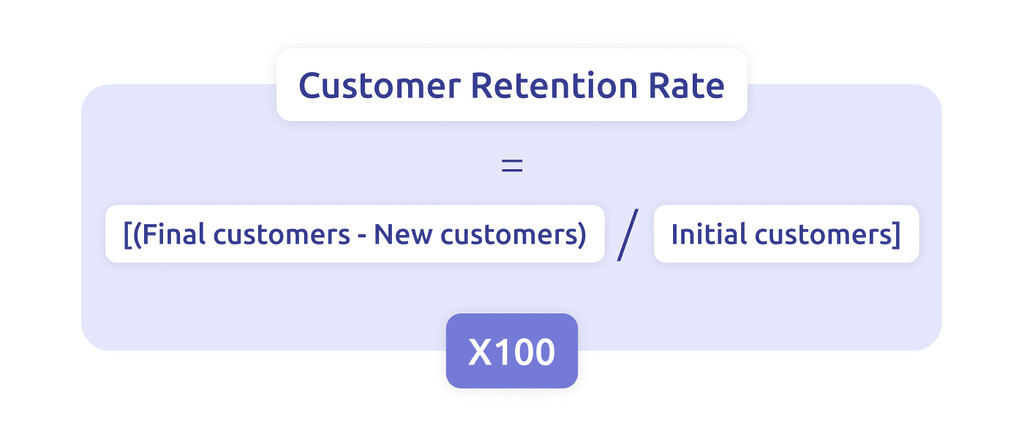What Is Customer Retention Rate?
The customer retention rate (CRR) is the percentage of customers who remain with your company over a specific period. It’s a measure of how well your organization maintains relationships and converts one-time interactions into ongoing engagement.
Retention is not just about avoiding churn—it’s about building loyalty. A strong retention rate shows that customers find consistent value in your products, services, and support. It reflects an ecosystem where sales, marketing, and customer service align to create meaningful experiences that keep people coming back.
For contact centers and CX teams, the retention rate serves as a pulse check of service performance: it captures how well your agents, processes, and technologies work together to create seamless, positive interactions.
How to Calculate Retention Rate
The formula is straightforward:

For example, if you begin the year with 1,000 customers, acquire 200 new ones, and end with 1,100, your retention rate is 90%.
While this formula gives you the number, the real value lies in understanding what drives it. Tracking customer retention rate over time helps you identify trends, uncover weak points in the customer journey, and measure the impact of initiatives such as training, automation, or experience redesign.
Retention vs. Churn: Two Sides of the Same Coin
If retention tells you how many customers stay, churn rate tells you how many leave. Both are critical metrics that reveal the strength of your customer relationships.
Churn can result from a variety of factors, including inadequate onboarding, inconsistent service, outdated technology, or a lack of personalization. A low retention rate, or high churn, shows that your customers may be seeking better experiences elsewhere.
For contact centers, the relationship between retention and churn is direct. A single negative interaction—such as long wait times, repetitive identification steps, or unresolved issues—can tip a loyal customer toward churn. Monitoring both rates provides a more complete picture of customer loyalty and satisfaction.
Why a High Retention Rate Matters for Your Business
A strong customer retention rate is a sign of stability and maturity. It demonstrates that your company can deliver consistent value, manage customer expectations, and foster long-term relationships—all of which are essential for sustainable growth.
A Strong Signal of Customer Trust and Satisfaction
When customers choose to stay, it means they believe in your brand. They feel recognized, understood, and confident that your team will meet their needs. Building genuine trust takes time and dedication, blossoming through meaningful conversations, resolutions, and interactions. For contact center leaders, retention data is an invaluable resource that reveals the strength of customer trust and loyalty!
High retention rates often correlate with strong first-contact resolution, empathetic service, and effective communication—three pillars of customer satisfaction.
A Foundation for Long-Term Profitability
Customer retention is also one of the most reliable drivers of profitability. Research from Bain & Company found that a 5% increase in retention can boost profits by up to 95%. That’s because loyal customers spend more, refer others, and require less marketing investment.
Moreover, retention stabilizes revenue. In industries where competition is fierce and customer acquisition costs are high—like telecom, e-commerce, or financial services—a loyal base ensures predictable income and steady growth.
A Powerful Growth and Brand Driver
Loyal customers are your most authentic advocates. They generate positive word of mouth, write reviews, and share experiences that strengthen your reputation. Unlike paid campaigns, these organic endorsements carry more weight because they come from real users.
A high customer retention rate not only improves financial performance—it also reinforces brand credibility. In markets where consumers have infinite choices, loyalty becomes a key differentiator that competitors can’t easily replicate.
How to Improve Your Customer Retention Rate

Increasing retention doesn’t happen by chance—it’s the result of deliberate strategy, supported by empathy, technology, and data.
Deliver an Exceptional Customer Experience
Customer experience (CX) is the foundation of loyalty. When service is seamless, personalized, and consistent across channels, customers are more likely to stay.
For contact centers, this means optimizing every step of the journey—from IVR menus and wait times to call routing and follow-ups. Empower agents with unified tools that let them access customer histories instantly. When interactions feel effortless, retention follows naturally.
Listen to and Anticipate Customer Needs
Retention starts with active listening. Collect feedback at key moments—post-call surveys, satisfaction forms, and digital reviews—and analyze it to identify patterns. Use these insights to anticipate what customers might need next, whether it’s proactive support or a tailored offer.
AI-driven analytics can help detect early signs of dissatisfaction, allowing teams to act before a customer decides to leave. By shifting from reactive to proactive engagement, businesses create a service experience that feels personal and attentive.
Empower and Train Your Teams
Agents are the cornerstone of retention. Even with advanced tools, the human touch remains irreplaceable. Well-trained, motivated teams deliver empathy and consistency—the qualities that turn interactions into relationships.
Continuous coaching and clear KPIs help maintain excellence. Contact center managers should focus on soft skills as much as operational ones: active listening, emotional intelligence, and ownership are all crucial to customer satisfaction and retention.
Leverage Data and AI to Personalize Engagement
The most successful CX strategies use data and AI to enhance—not replace—human interactions. Predictive models can identify at-risk customers, while automation ensures timely and relevant responses.
For instance, AI can route calls to the most qualified agent, transcribe conversations for quality monitoring, or surface insights that help teams tailor their approach. These capabilities create proactive, intelligent experiences that make customers feel known and valued—key drivers of retention.
Complementary KPIs That Complete the Retention Picture
The customer retention rate is essential, but it rarely tells the whole story. To truly understand loyalty, CX leaders should analyze it alongside other key performance indicators.
Net Promoter Score (NPS)
NPS measures how likely customers are to recommend your company. A high NPS indicates strong satisfaction and emotional connection—factors closely tied to retention. Tracking both metrics together helps you see whether your loyal customers are also active promoters.
Customer Satisfaction Score (CSAT)
CSAT reflects how satisfied customers are after specific interactions. A dip in CSAT often predicts future churn. Monitoring it across touchpoints—especially after support interactions—helps teams identify issues before they impact retention.
Customer Effort Score (CES)
CES measures how easy it is for customers to resolve an issue or complete a task. The less effort required, the higher the loyalty. Simplifying processes, reducing repetitive questions, and enabling omnichannel continuity all contribute to stronger retention outcomes.
Why Combining These KPIs With Retention Matters
Each KPI provides a different lens on the customer relationship. Together, they offer a 360-degree view of loyalty.
Analyzing NPS, CSAT, CES, and retention together allows leaders to identify not just how many customers stay, but also why they stay and what motivates them to engage more deeply with the brand.
CCaaS: The All-in-One Solution for Customer Loyalty
Technology plays a decisive role in driving retention, especially through modern Contact Center as a Service (CCaaS) platforms. These cloud-based solutions help organizations deliver consistent, high-quality experiences that strengthen customer loyalty.
What Is a CCaaS Platform?
A CCaaS platform unifies all customer interactions—voice, chat, email, and social—into a single centralized system. This integration enables faster responses, data-driven insights, and real-time collaboration between agents and supervisors.
By leveraging a CCaaS solution, contact centers gain flexibility, scalability, and visibility—three critical factors for maintaining strong customer retention in a dynamic market.
CRM and Business Tool Integrations
Integrating your CCaaS platform with your CRM (such as Salesforce or HubSpot) provides agents with a 360-degree view of each customer’s journey. This context empowers personalized interactions, faster problem-solving, and more efficient service—key factors in retaining customers over time.
AI and Automation Capabilities
AI-driven features like voice analytics, intelligent routing, and automated quality monitoring help agents work smarter. They free up time for meaningful conversations and ensure customers receive the right support at the right moment.
Automation also reduces friction by streamlining repetitive tasks and providing real-time suggestions that enhance service quality.
Conclusion: Retention Rate as the True Reflection of Customer Relationships
Your customer retention rate is more than just a performance metric—it’s the mirror of your organization’s ability to create lasting value and emotional connection. In a market where customers have endless alternatives, loyalty has become a strategic asset that defines growth and resilience.
By focusing on exceptional experiences, empowered teams, and smart technologies, contact centers can transform retention from a numerical goal into a genuine culture of loyalty—one where every customer interaction strengthens the relationship and contributes to sustainable business success.
Track fidelity with customer retention rate



